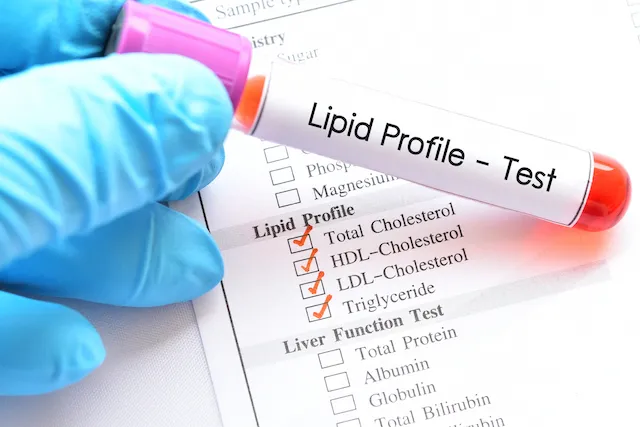Looking for a Personalized Diet Plan?
Managing Dyslipidemia: Improve Your Cholesterol and Triglycerides

Dyslipidemia is a condition characterized by abnormal levels of lipids in the blood, which includes elevated LDL ("bad" cholesterol) and triglycerides, alongside reduced HDL ("good" cholesterol).
This imbalance is a primary causative factor for the development of cardiovascular diseases (CVD), which are among the leading causes of death globally.
Managing dyslipidemia through dietary interventions is one of the most effective ways to lower CVD risk.
In a study conducted by Tracy et al. (2016), the impact of a brief dietary intervention on hyperlipidemic adults showed a significant reduction in total cholesterol, triglycerides, LDL, and total energy intake, as well as improvements in HDL cholesterol and body mass index (BMI) after just six weeks.1
This highlights the power of dietary changes in managing cholesterol levels and improving heart health.
This blog explores dyslipidemia, its risks, and the role of a heart-healthy diet in managing this condition.
We’ll also discuss how the Dyslipidemia Diet Plan available through the Hint app can support those looking to improve their cholesterol profile and reduce the risk of heart disease.
What is Dyslipidemia?
Dyslipidemia refers to abnormal levels of lipids in the blood, typically involving:
- High levels of LDL (bad cholesterol): LDL cholesterol can build up in the walls of your arteries, leading to atherosclerosis and increasing the risk of heart attacks and strokes.
- Elevated triglycerides: Triglycerides are another type of fat in the blood that, when elevated, contribute to plaque formation and increase the risk of heart disease.
- Low levels of HDL (good cholesterol): HDL helps remove LDL cholesterol from the bloodstream. Low levels of HDL can increase the risk of cardiovascular complications.
Reference Ranges for Lipid Profiles2,3,4
Understanding your lipid profile is key to managing dyslipidemia. Here are the reference ranges for adults and children, indicating healthy and risky levels:
For Adults:
HDL Cholesterol:
- Low (Increased risk): Less than 40 mg/dL (men), less than 50 mg/dL (women)
- Optimal: 60 mg/dL or higher
LDL Cholesterol:
- Optimal: Less than 100 mg/dL
- Near/Above Optimal: 100-129 mg/dL
- High: 160-189 mg/dL
- Very High: Greater than 190 mg/dL
Total Cholesterol:
- Desirable: Less than 200 mg/dL
- High: 240 mg/dL or higher
Triglycerides:
- Optimal: Less than 150 mg/dL
- Very High: Greater than 500 mg/dL
Non-HDL Cholesterol:
- Optimal: Less than 130 mg/dL
- Very High: Greater than 220 mg/dL
For Children and Young Adults:
Total Cholesterol:
- Acceptable: Less than 170 mg/dL (children and teens), less than 190 mg/dL (young adults)
- High: Greater than 200 mg/dL (children), greater than 225 mg/dL (young adults)
Non-HDL Cholesterol:
- Acceptable: Less than 120 mg/dL (children), less than 150 mg/dL (young adults)
- High: Greater than 145 mg/dL (children), greater than 190 mg/dL (young adults)
Managing Dyslipidemia Through Diet
Diet plays a pivotal role in managing dyslipidemia and reducing the risk of cardiovascular diseases. Here are some key strategies to help manage lipid levels:
Reduce Saturated and Trans Fats
Saturated fats, found in red meat, butter, and certain oils (like palm and coconut oil), can raise LDL levels. Trans fats, often found in fried and processed foods, are even more harmful.
Reducing these fats in your diet is one of the most effective ways to lower LDL cholesterol.
Increase Healthy Fats
Monounsaturated (MUFA) and polyunsaturated fats (PUFA) found in nuts, seeds, fatty fish, and certain oils like olive oil and mustard oil can help raise HDL levels and lower LDL cholesterol.
Incorporating foods like almonds, walnuts, and fatty fish such as salmon and mackerel can positively impact your lipid profile.
Eat More Fiber-Rich Foods
Soluble fiber found in foods like oats, beans, and lentils can help reduce the absorption of cholesterol into your bloodstream.
Fiber also promotes weight loss and better digestive health, both of which contribute to improved cholesterol management.
Limit Refined Carbohydrates
Refined carbohydrates, such as white bread and sugary snacks, can raise triglyceride levels.
Replacing these with whole grains like brown rice, quinoa, and barley will help stabilize blood sugar levels and promote heart health.
Dyslipidemia Diet Plan on the Hint App
For those managing dyslipidemia, the Dyslipidemia Diet Plan available through the Hint app offers personalized meal plans and nutritional tracking to help you control your cholesterol and triglyceride levels effectively. The plan is available via Hint Pro and Hint Premium and includes:
- Personalized Meal Plans: Tailored to your specific cholesterol and triglyceride goals, the Dyslipidemia Diet Plan provides daily meal suggestions that incorporate heart-healthy fats, high-fiber foods, and complex carbohydrates.
- Advanced Nutrition Tracking: Track your intake of fats, carbohydrates, and fiber to ensure you're on track to meet your heart health goals.
- Unlimited Dietitian Consultations: With Hint Premium, you get access to expert dietitians who can provide personalized advice and make adjustments to your meal plan based on your lipid profile.
By following this diet plan, you can take control of your dyslipidemia and significantly lower your risk of cardiovascular diseases.
References
- Schumacher, T. L., Burrows, T. L., Rollo, M. E., Spratt, N. J., Callister, R., & Collins, C. E. (2016). Effectiveness of a Brief Dietetic Intervention for Hyperlipidaemic Adults Using Individually-Tailored Dietary Feedback. Healthcare (Basel, Switzerland), 4(4), 75.
- Smith et al, Lab tests online; American Association for Clinical Chemistry (AACC)2001-2020.
- Wintrobe's Clinical Hematology. 14th ed. Greer J, editor. Philadelphia, PA: Wolters Kluwer: 2019.
- Henry's Clinical Diagnosis and Management by Laboratory Methods. 22nd ed. McPherson R, Pincus M, eds. Philadelphia, PA: Elsevier Saunders; 2011.






